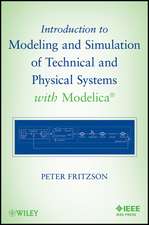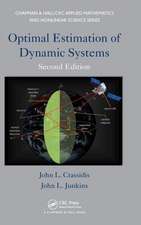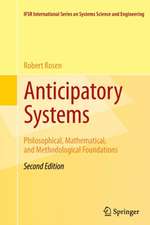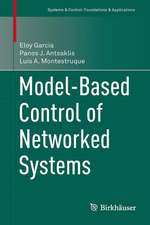Codes on Algebraic Curves
Autor Serguei A. Stepanoven Limba Engleză Hardback – 30 iul 1999
| Toate formatele și edițiile | Preț | Express |
|---|---|---|
| Paperback (1) | 947.04 lei 6-8 săpt. | |
| Springer Us – 20 oct 2012 | 947.04 lei 6-8 săpt. | |
| Hardback (1) | 954.77 lei 6-8 săpt. | |
| Springer Us – 30 iul 1999 | 954.77 lei 6-8 săpt. |
Preț: 954.77 lei
Preț vechi: 1164.35 lei
-18% Nou
Puncte Express: 1432
Preț estimativ în valută:
182.70€ • 191.39$ • 151.41£
182.70€ • 191.39$ • 151.41£
Carte tipărită la comandă
Livrare economică 08-22 aprilie
Preluare comenzi: 021 569.72.76
Specificații
ISBN-13: 9780306461446
ISBN-10: 0306461447
Pagini: 350
Ilustrații: XIII, 350 p.
Dimensiuni: 152 x 229 x 25 mm
Greutate: 0.71 kg
Ediția:1999
Editura: Springer Us
Colecția Springer
Locul publicării:New York, NY, United States
ISBN-10: 0306461447
Pagini: 350
Ilustrații: XIII, 350 p.
Dimensiuni: 152 x 229 x 25 mm
Greutate: 0.71 kg
Ediția:1999
Editura: Springer Us
Colecția Springer
Locul publicării:New York, NY, United States
Public țintă
ResearchDescriere
This is a self-contained introduction to algebraic curves over finite fields and geometric Goppa codes. There are four main divisions in the book. The first is a brief exposition of basic concepts and facts of the theory of error-correcting codes (Part I). The second is a complete presentation of the theory of algebraic curves, especially the curves defined over finite fields (Part II). The third is a detailed description of the theory of classical modular curves and their reduction modulo a prime number (Part III). The fourth (and basic) is the construction of geometric Goppa codes and the production of asymptotically good linear codes coming from algebraic curves over finite fields (Part IV). The theory of geometric Goppa codes is a fascinating topic where two extremes meet: the highly abstract and deep theory of algebraic (specifically modular) curves over finite fields and the very concrete problems in the engineering of information transmission. At the present time there are two essentially different ways to produce asymptotically good codes coming from algebraic curves over a finite field with an extremely large number of rational points. The first way, developed by M. A. Tsfasman, S. G. Vladut and Th. Zink [210], is rather difficult and assumes a serious acquaintance with the theory of modular curves and their reduction modulo a prime number. The second way, proposed recently by A.
Cuprins
I. Error-Correcting Codes.- 1 Codes and Their Parameters.- 1.1. Introduction.- 1.2. Finite Fields.- 1.3. Linear Codes.- 1.4. Spectrum and Duality.- Exercises.- 2 Bounds on Codes.- 2.1. Upper Bounds.- 2.2. The Linear Programming Bound.- 2.3. Lower Bounds.- Exercises.- 3 Examples and Constructions.- 3.1. Codes of Genus Zero.- 3.2. Some Families of Codes.- 3.3. Constructing Codes from other Codes.- Exercises.- II. Algebraic Curves and Varieties.- 4 Algebraic Curves.- 4.1. Algebraic Varieties.- 4.2. Non-Singular Curves.- 4.3. Divisors on Algebraic Curves.- 4.4. The Riemann—Roch Theorem.- 4.5. Hurwitz and Plücker Genus Formulas.- 4.6. Special Divisors.- Exercises.- 5 Curves over a Finite Field.- 5.1. Rational Points and Divisors.- 5.2. The Zeta-Function of a Curve.- 5.3. L-Functions of Artin.- 5.4. Algebraic Function Fields.- Exercises.- 6 Counting Points on Curves over Finite Fields.- 6.1. The Number of Rational Points on a Curve.- 6.2. Character Sums.- 6.3. Asymptotics.- Exercises.- III. Elliptic and Modular Curves.- 7 Elliptic Curves.- 7.1. The Group Law.- 7.2. The j-Invariant.- 7.3. Isogenies.- 7.4. Elliptic Curves over Finite Fields.- 7.5. Elliptic Functions.- Exercises.- 8 Classical Modular Curves.- 8.1. Congruence Subgroups.- 8.2. The Curves X(N), X0(N), and X1(N).- 8.3. Hecke Operators.- 8.4. The Petersson Inner Product.- Exercises.- 9 Reductions of Modular Curves.- 9.1. Reductions and Moduli Spaces.- 9.2. The Igusa Theorem.- 9.3. The Eichler-Shimura Congruence Relation.- 9.4. The Eichler-Selberg Trace Formula.- Exercises.- IV. Geometric Goppa Codes.- 10 Constructions and Properties.- 10.1. L-Construction.- 10.2. ?-Construction.- 10.3. Parameters.- 10.4. Duality and Spectra.- Exercises.- 11 Examples.- 11.1. Codes of Small Genera.- 11.2. Elliptic and Hermitian Codes.- 11.3. Codes on Fiber Products.- 11.4. Codes on Classical Modular Curves.- 11.5. Codes on Artin—Schreier Coverings.- 11.6. Codes on Trace-Norm Curves.- Exercises.- 12 Decoding Geometric Goppa Codes.- 12.1. The Decoding Problem.- 12.2. The Basic and Modified Algorithms.- 12.3. An Improvement of the Modified Algorithm.- 12.4. Majority Voting for Unknown Syndromes.- 12.5. Faster Decoding.- Exercises.- 13 Bounds.- 13.1. Asymptotic Bounds.- 13.2. Constructive Bounds.- 13.3. Other Bounds.- Exercises.- List of Notations.
















